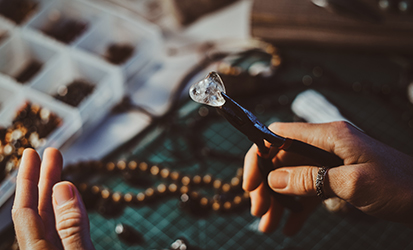Diamonds have long been symbols of luxury, romance, and status. Their timeless appeal and enduring value have made them a cornerstone of global trade. However, the diamond industry, particularly the polished diamond market, is experiencing dynamic changes influenced by shifting consumer behaviors, technological advancements, and environmental concerns. As the global market continues to evolve, understanding the latest trends and opportunities in polished diamonds is crucial for industry players, investors, and enthusiasts.
The State of the Polished Diamond Market
The polished diamond market refers to diamonds that have been cut, polished, and finished for use in jewelry, investments, or other decorative purposes. The market is a key component of the broader diamond industry, which also includes rough diamond extraction, mining, and wholesale distribution.
In recent years, the polished diamond sector has been shaped by several significant trends, including technological advancements in diamond cutting and grading, the rise of synthetic diamonds, and evolving consumer preferences. Let’s delve deeper into the key factors driving these changes and explore the emerging opportunities within the global market.
1. Rising Demand for Sustainable and Ethical Sourcing
With growing awareness about the environmental and social impact of diamond mining, consumers and companies are increasingly prioritizing sustainability and ethical sourcing. This trend is leading to a rise in the demand for “conflict-free” and “responsibly sourced” diamonds, including those from companies that adhere to the Kimberley Process Certification Scheme (KPCS), which aims to prevent the trade in conflict diamonds.
Opportunity: Diamond producers and retailers who adopt sustainable practices and transparent supply chains stand to gain the trust of ethically conscious consumers. Additionally, diamonds that are certified by organizations like the Responsible Jewellery Council (RJC) may find favor in a market that values social responsibility.
2. The Emergence of Lab-Grown Diamonds
In recent years, lab-grown diamonds have emerged as a viable alternative to mined diamonds. These diamonds are chemically, physically, and optically identical to natural diamonds but are produced in a controlled environment, making them more affordable and environmentally friendly. According to reports, the lab-grown diamond market has experienced rapid growth, and its popularity continues to rise, particularly among younger generations.
Opportunity: Lab-grown diamonds offer an affordable and sustainable option, which appeals to price-conscious and eco-conscious consumers. As technology continues to improve, the quality of lab-grown diamonds will only get better, providing an exciting opportunity for the industry to innovate and cater to different market segments. Retailers and jewelers who embrace these diamonds and market them effectively are well-positioned to capture a significant share of the growing demand.
3. Technological Advancements in Diamond Cutting and Grading
Advancements in diamond cutting technology have enabled manufacturers to produce more intricate and precise cuts, enhancing the brilliance and visual appeal of diamonds. Innovations like computer-aided design (CAD) software, laser cutting, and automated polishing machines have streamlined the diamond cutting process, leading to higher-quality polished diamonds at competitive prices.
In addition, advancements in diamond grading technology, such as the use of artificial intelligence (AI) and machine learning algorithms, are helping to improve the accuracy and consistency of diamond grading. These technologies offer a more transparent and objective grading system, which can lead to better customer trust and more informed purchasing decisions.
Opportunity: Jewelers and manufacturers who invest in cutting-edge technology to produce high-quality diamonds and offer precise grading will have a competitive edge in the marketplace. Additionally, technology-driven transparency in the grading process can help alleviate concerns regarding the authenticity of diamonds, especially with the increasing popularity of synthetic diamonds.

4. Changing Consumer Preferences and the Influence of Millennials
Millennials and Gen Z are transforming the global diamond market. These younger consumers are more informed, value sustainability, and are increasingly seeking unique and personalized products. Their preference for experiences over material goods, as well as the growing acceptance of alternative gemstones, has altered the landscape of the diamond market.
Opportunity: Jewelers who cater to these younger generations by offering customized designs, eco-friendly options, and ethically sourced diamonds are likely to capture the attention of these socially aware and discerning customers. The rise of online platforms and digital marketplaces also presents an opportunity to engage with younger consumers through innovative marketing strategies, including social media campaigns and influencer partnerships.
5. Digital Transformation and Online Sales Channels
The digitalization of the diamond industry has accelerated, particularly due to the COVID-19 pandemic, which forced many brick-and-mortar retailers to pivot to online sales channels. Today, consumers are increasingly turning to online platforms to purchase diamonds, seeking convenience, transparency, and a wider range of options. E-commerce platforms and online marketplaces for diamonds have gained significant traction, allowing customers to shop from the comfort of their homes.
Opportunity: The growing preference for online shopping presents a significant opportunity for diamond retailers to expand their reach. By adopting advanced digital tools like virtual try-on technologies, 3D visualization, and augmented reality (AR), companies can enhance the customer experience and provide a seamless online purchasing journey. Additionally, adopting e-commerce solutions can help businesses tap into international markets and reach a global customer base.
6. Global Market Growth and Emerging Economies
While the diamond market in developed regions like North America and Europe remains strong, the real growth is occurring in emerging markets such as China, India, and the Middle East. As these regions continue to grow economically and their middle class expands, the demand for luxury goods, including diamonds, is expected to rise.
Opportunity: Companies looking to expand their footprint in the global market should consider tailoring their marketing strategies to cater to local preferences, cultures, and purchasing habits in emerging markets. Furthermore, the growing affluence in these regions creates a lucrative opportunity for diamond producers and retailers to establish a presence and create a strong brand identity.
7. Resilient Investment Potential
Diamonds have long been regarded as a stable investment option, with their value typically appreciating over time. Despite the volatility in global markets, polished diamonds continue to be seen as a hedge against inflation and economic uncertainty. Particularly rare and high-quality diamonds, such as pink, blue, and green diamonds, continue to see strong demand from investors.
Opportunity: As global wealth continues to rise, particularly in developing economies, the investment demand for high-end diamonds is likely to increase. Investors and collectors looking for a store of value may increasingly turn to polished diamonds, providing opportunities for traders, auction houses, and jewelers to cater to this growing market segment.

